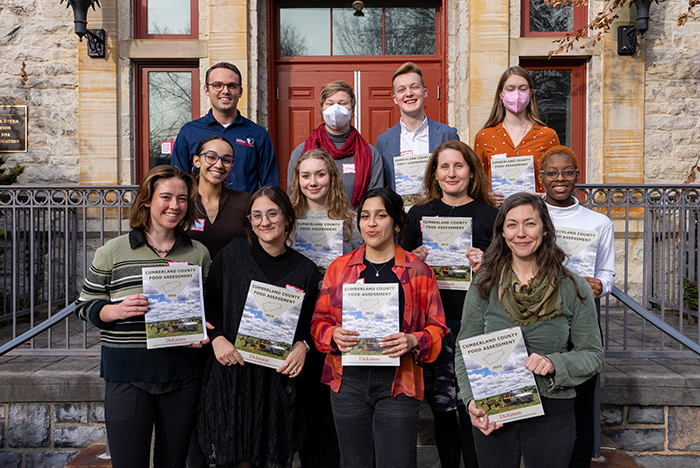Students Research, Report on Food Access in Cumberland County, Pa.

Student-researchers pose with their reports of original research on food access in Cumberland County, Pa. The students presented their work in early December. Photo by Dan Loh.
Report includes perspectives of nonprofit leaders, food pantry guests
MaryAlice Bitts-Jackson
Forty-four percent of people who use food pantries in Cumberland County, Pa., must regularly skip meals to make ends meet. And children in the county are 38% more likely to be food insecure than their adult counterparts. Knowing these distressing truths can help regional organizations better meet the needs of vulnerable populations.
That’s the idea behind an immersive class project that invited students to partner with local and regional community members to study issues relating to food access in the local community and deliver recommendations on steps to alleviate hunger in Dickinson’s home county.
The class, Environmental Research Methods and Civic Engagement, was taught by Heather Bedi, associate professor of environmental studies. The research was supported by a grant provided by Dickinson’s Center for Civic Learning & Action.
How it worked
Working with Central Pennsylvania Food Bank (CPFB) and the Cumberland County Food System Alliance (CCFSA), the student researchers identified areas in need of study, according to regional stakeholders. They developed and conducted interviews of local nonprofit leaders and conducted surveys of 365 guests at seven regional food pantries. They also dove into related data to illuminate national, statewide and countywide trends. And they analyzed their findings.
Studying food access, the students analyzed the prevalence of farmland in Cumberland County, quantified food retailers and compared prices for like items at five supermarkets in Carlisle. Investigating territory restrictions within the county, which make particular services available to individuals based on zip code, the students discovered that where people live within Cumberland County has a bearing on the number and types of services available to them.
The students also studied challenges facing charitable food organizations, including the expiration of benefits awarded during the heart of the COVID-19 pandemic, as well as additional barriers to services and programs that include the Supplementary Nutrition Assistance Program (SNAP). And they looked at food waste and client preferences in terms of food pantry delivery systems and clients’ overall assessment of local and regional organizations and services.
Their recommendations
On Dec. 14, the student researchers presented their report during an event open to local nonprofit leaders, food assistance recipients and members of the campus community. The public on-campus event included remarks by President John E. Jones III ’77, P’11.
They recommended that charitable food organizations ease service territory requirements to increase choice and access countywide and that related organizations in Cumberland County focus on the most vulnerable populations, including children. To that end, the students advised organizations to take advantage of the Pennsylvania governor’s free school-breakfast program and establish after-school alternative models to combat child hunger. They also advised related Cumberland County nonprofits to expand SNAP educational outreach efforts.
Immediate effects
As Bedi notes, opportunities like these provide in-the-field experience to students and also can yield valuable connections. Recent grad Laura Whitaker ’22, alerted to a job opportunity at the CPFB by faculty and now working there, provided one-on-one assistance to the student researchers. One of the students is investigating an internship at a local organization involved with the project.
But the most consequential part of the project for the students? Knowing that their work will be used by local nonprofits as a resource guide. At the time of this writing, one such organization, New Hope Ministries, had already posted the student report on its website.
Knowing that their findings would be put to use focused the student researchers and deepened their connections to the project, says Sophie Walsh ’23 (environmental studies). Walsh, who worked with Natalia Uro-De Leon ’24 (environmental science) on the food-access section of the report and also contributed to an additional section on food pantry waste, was also grateful for the opportunity to include the perspectives of food pantry guests in the report.
“The stories and background of our surveyed food pantry guests allowed us to voice their real concerns and barriers,” she says. “It really highlighted the importance of who our research is really for—the people affected by a challenging food system in their everyday lives.”
TAKE THE NEXT STEPS
Published December 16, 2022